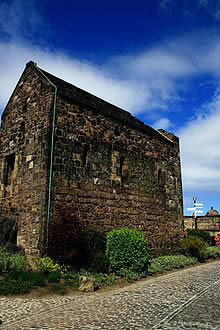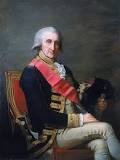
Edinburgh Castle situated in Pedro district, St. Ann, was built by Lewis Hutchinson, who is Jamaica’s earliest recorded serial killer. Hutchinson, a Scottish Doctor came to Jamaica in the 1760’s. The two storey ‘castle’ has two circular loop holed towers placed diagonally at opposite corners.
Lewis Hutchinson, also known as “the mad doctor”, with a single shot would kill any lone passer-by. He would then force his slaves to throw the body of his victim in a sinkhole located on the property. In his worst dementia he would invite his victims to his castle where they would be entertained before being killed.
After a time the Doctor seemed to have become more daring as he shot his neighbour and a soldier in full view of a white colonist. The “mad doctor” tried to make good his escape on a ship about to set sail. However, he was captured, tried and hanged at the Spanish Town Gallows in 1773.
The final count of people murdered by Hutchinson will never be known. However, upon searching his home after his arrest forty three (43) watches and a large amount of clothing were found.
The “castle” now stands in ruins.
Criminality

In the 1760s, he came to Jamaica to head an estate called Edinburgh Castle. He was said to have legally obtained the house (now a ruin) but to have maintained his group of cattle through the theft of strays from neighbors. This would not be the only accusation made of Hutchinson.
Shortly after Hutchinson’s arrival in Jamaica, travelers began to disappear, and suspicion started to mount. For many miles, Edinburgh Castle was the only populated location on the way from Saint Ann’s Bay, and, not knowing that they would become the target of Hutchinson’s rifle, travelers would rest at the castle, only to succumb to the Mad Doctor’s attack. Hutchinson murdered for pure sport, what may be described as a thrill killing, as passers-by from all races, shapes, sizes, and incomes were fair game.
What is true about Hutchinson’s killings is debatable. He would shoot lone travelers and was said to feed on the flow of his victims’ blood as well as dismember them. He or, according to some sources, his slaves would then toss the remains in a cotton tree or a sinkhole for animals to feast on. That sinkhole became known as Hutchinson’s Hole. At the height of his villainy, he would invite guests to his castle to be entertained before killing them
Hutchinson’s reputation for debauchery made him notable as many would avoid him out of fear. His slaves’ tales of terrible treatment and the gruesome details of the murders made him legendary. This is why he was allowed to roam free for a time, until he shot an English soldier by the name of John Calendar, who attempted to apprehend Hutchinson. After Hutchinson shot Calendar, he bolted south to Old Harbour and boarded a ship. The Royal Navy, commanded by Admiral Rodney, caught Hutchinson before he could escape.
Trial and (Supposedly) Execution
Shortly after being caught, he was tried and found guilty. In 1773, he was hanged in Spanish Town Square. Although the final toll is unknown, upon searching his home after his arrest, approximately 43 watches and a large amount of clothing was found. The records of his trial stand in the National Archives and in the Jamaican ArchivesShortly after being caught, he was tried and found guilty. In 1773, he was hanged in Spanish Town Square. Although the final toll is unknown, upon searching his home after his arrest, approximately 43 watches and a large amount of clothing was found. The records of his trial stand in the National Archives and in the Jamaican Archives.
Accomplices
During the trial, slaves’ stories revealed he did not act alone. Planter James Walker and Roger Maddix were sentenced to death for participating in the murder of farmer William Lickley and schoolmaster Timothy Cronin. Maddix’s wife, Dorcas, Miss Susanna Cole and Miss Elizabeth Thomas watched schoolmaster Cronin’s death by strangulation while pinioned in stocks. Cronin’s watch and seal were found in Thomas’ possession.
Miss Thomas was found not guilty

Hutchison, known better as the Mad Master of Edinburgh Castle, was born in Scotland in 1733 where he is believed to have studied medicine for a while. He came to Jamaica in the 1760s to run an estate on which a house known as Edinburgh Castle sat. Although he is said to have acquired the land legally, his collection of cattle was said to consist mostly of strays from neighbouring pens. Cattle stealing, however, was the least of red-haired Hutchison’s sins.
Not too long after Hutchison’s arrival, cases of travellers disappearing without a trace began to mount in number and suspicions ran rampant but no one could ever have suspected the level of torture they experienced. Travellers would occasionally stop to rest at Edinburgh Castle, the only inhabited spot for miles on the way from St. Ann’s Bay south not knowing that they would become the target of Hutchison’s unerring aim. Hutchison killed for sport, not money, as travellers of all shapes, sizes and income levels were equal game. It is said that he fed off the flow of blood and often dismembered his victims and left them in the hollow trunk of a cotton tree, a sinkhole, for the vultures to carry on where he left off. The hole became known as “Hutchison’s Hole”.
Hutchison’s slaves added their own tales of mistreatment and his reputation for evil-doing became legend. In fact, his reputation for villainy was such that no one wanted to go near him if they could avoid it. Therefore, great hesitation and fear took root amongst those officials who could serve him with a warrant. Time continued to pass and still Hutchison remained free. Not even his brutal and unwarranted attack on his unarmed neighbour Dr. Hutton, which caused the good doctor, who was en route to join his family on a trip to England, to wear a silver plate in his head for the remainder of his life, changed things. Eventually, however, a young English soldier, John Callendar, bravely set out to bring Hutchison in. Hutchison calmly shot him on sight but aware that more soldiers would follow their comrade, he is then said to have fled south to Old Harbour where he set off by sea. Unbeknownst to Hutchison, the Royal Navy, commanded by the venerable Admiral Rodney (whose statue now stands in Spanish Town Square) was keeping watch and Hutchison’s craft was intercepted. Hutchison, increasingly desperate, tried to leap overboard but his red hair made him easy to see and he wasn’t able to get very far. Admiral Rodney was congratulated by Jamaica’s House of Assembly for his assistance in apprehending Hutchison and placing him securely behind bars.
Legal proceedings against the Mad Master of Edinburgh Castle commenced and soon tales of devilry and debauchery that almost defy the imagination began to surface. Edinburgh Castle was searched and clothing said to have belonged to his victims, those travellers who had disappeared, were found. Hutchison’s slaves eagerly relinquished their long-held silence, detailing crime after crime but all were heresay judged unfit to stand up in a court of law. So Hutchison, who was believed to have committed multiple murders, was tried for one murder and one murder only, that of English soldier John Callendar. During the trial, however, the stories of his slaves were substantiated and it was further revealed that Hutchison had not carried out his evil acts alone the existence of a neighbouring group of perverted minds was also revealed. A few members, planter James Walker and Roger Maddix, were tried, found guilty and condemned to death for their own parts in the murder of farmer William Lickley and schoolmaster Timothy Cronin. It is said that along with Roger Maddix and Lewis Hutchison, Maddix’s wife, Dorcas, a Miss Susanna Cole and a Miss Elizabeth Thomas watched schoolmaster Cronin’s death by strangulation while pinioned in stocks. Cronin’s watch and seal were later found in Elizabeth Thomas’ posse ssion. Miss Thomas was tried, pled not guilty and received judgment as such.
 |
| The eerie remains of Edinburgh Castle. Even today, locals stay away from the castle, as it is said that the ghosts of those tortured still roam, specially at night. |
Lewis Hutchison was not so lucky however. Although he insolently entered a plea of not guilty and was defended by one of the island’s most esteemed lawyers, he was tried, found guilty and condemned to death by hanging in Spanish Town Square. The records of his trial stand in the National Archives.
Defiant even in death, Hutchison left funds to inscribe his two-line epitaph on his marble tombstone: “Their sentence, pride and malice, I defy. Despise their power, and like a Roman, die”. His wishes, as befitting the mark of such a man, were ignored.
Today the ruins of Edinburgh Castle still stand, silently, betraying no hint of the acts of evil that took place centuries ago. The actions of the Mad Master of Edinburgh Castle, like those of another macabre character, Anne Palmer, the White Witch of Rose Hall, live on in the annals of Jamaican history.
